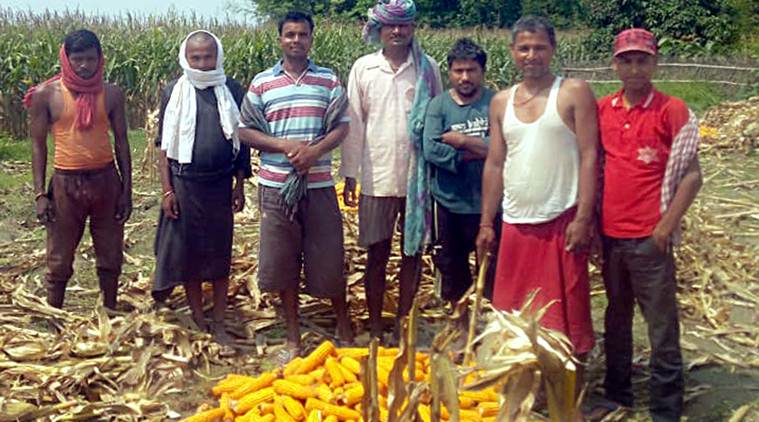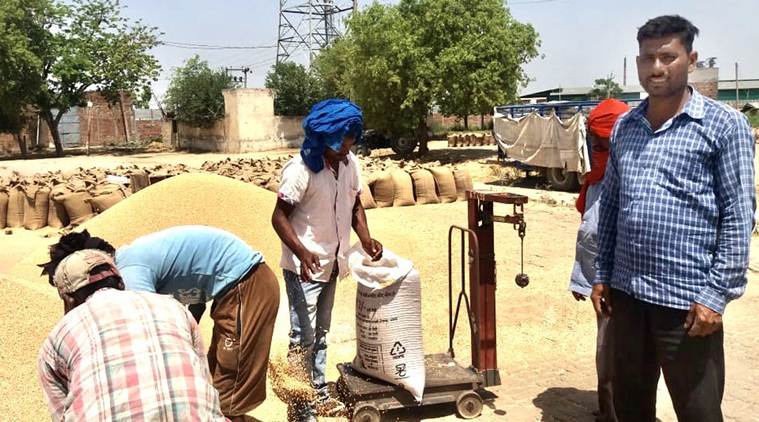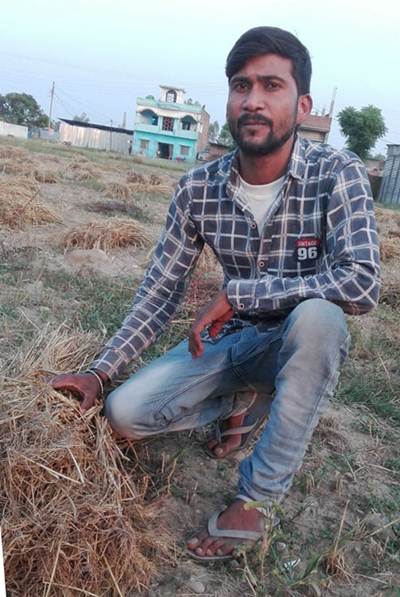 Jaipu Sharma with other farm labourers at his village in Bihar’s Purnia district.
Jaipu Sharma with other farm labourers at his village in Bihar’s Purnia district.
Jaipu Sharma is anxious for train services to resume. “If they start running today, I’ll be the first to board and reach my destination tomorrow,” remarks the 30-year-old. That is a sentiment voiced by many migrant labourers from Bihar stranded and out-of-work amid the nationwide lockdown. But unlike these men, desperate to go back home several hundred kilometers away, Sharma’s journey of interest is the reverse – from his village of Singhpur in Rupauli block of Bihar’s Purnia district to “anywhere in Punjab”.
Sharma is a farm labourer who spends 8-9 months of the year in Punjab. “I would have been busy harvesting wheat there now. Instead, I am stuck harvesting rabi maize here, which pays Rs 200-250 daily and the work will be over in the next 10 days. There, I get Rs 350-400 and the sardarjis (landowners) also provide 5 kg of dry ration (inclusive of flour, dal, salt and spices) per acre,” he says.
Sharma has been at Singhpur since mid-January and was supposed to return to Punjab by April 1, in time for wheat procurement. He is keen not to miss out on paddy transplanting that starts from mid-June. “The government has declared that farming activity will continue even during lockdown. But for that, labourers have to be allowed to move. Hamare bina jeeri lagana kaise ho paayega (how can transplanting happen without us)? They should start sending trains from here. Not only I, but my entire village’s labourers are ready to leave for Punjab,” he adds.
Sharma has been coming to Punjab for the last 15 years, working mainly for Gurmail Singh of Dhadda Haripur village in Jalandhar’s Nakodar tehsil and Bagga Singh of Khichipur near Adampur in the same district. “I first harvest their wheat in April and spring maize by early-June, before taking up paddy transplanting paddy till July-end. I also sow potato in early-October and harvest (for table use) by end-December. In between, I do loading work at the APMC (agricultural produce market committee) mandis during the paddy procurement season from mid-October to November. I am at my village only in January-March. Had I known about this lockdown (from March 22), I would have left by the middle of the month,” he sighs.
 Labour contractor Mohammad Naiyum at Shahkot mandi in Jalandhar district.
Labour contractor Mohammad Naiyum at Shahkot mandi in Jalandhar district.
Like Sharma, Manoj Kumar (24), too, is landless and restless. He, along with 11 others from Sisauwa village in Shahjahanpur tehsil and district of central Uttar Pradesh, are counting the days of lockdown that has been extended for two more weeks from May 4. “I make Rs 35,000-40,000 from transplanting paddy over 40 days, mainly for Dharmendra Singh and other farmers of Ugrahan (in Sangrur district’s Sunam tehsil). Neither I nor sardarji know what lies in store this time. The government is arranging trains for migrant workers to return to their homes. Why can’t the same be done also for those wanting to go back for work?” he asks.
Paddy transplanting is normally done by labourers in groups. “Six of us can cover two acres daily or 60 acres in a month. At Rs 2,500-3,500 per acre, the rate varying depending on supply and demand, we earn Rs 25,000-35,000. The sardarji further takes care of our food and housing next to the tubewell in his field,” explains Kumar.
The Indian Express had previously reported how Punjab and Haryana are facing the prospect of a shortage of up to 1 million labourers from Bihar and UP, who undertake the bulk of paddy transplanting operations in the two granary states.
Suman Kumar Mandal has five acres of jointly owned land at Parsagarhi village in Tribeniganj block of Bihar’s Supaul district. The 25-year-old’s main income source, however, is from supplying over 50 labourers to farmers in Sangrur. “I had booked all their tickets on a Garib Rath Express for March 25. My sardarji (Raghbir Singh from Kanoi village in the same district) is now calling me daily, asking how he would transplant paddy on his 18 acres. The government should start special trains immediately, so that enough labourers can be brought by early-June without risking spread of the (Covid-19) virus,” he points out.
 Mohammad Naiyum
Mohammad NaiyumMandal stays mostly in Punjab and goes to his village around February only to recruit farm labour. His wheat and maize farming operations, and also a small shop in the village, are managed by other family members.
At the Shahkot APMC market in Jalandhar where he works as a labourer, Mohammad Naiyum, better known as ‘Parkash Bihari’, is a worried man. A native of Narda village in Bihar’s Madhepura district, who speaks flawless Punjabi, the 38-year-old is also in the business of arranging farm labour.
“I had brought 30 labourers from Bhagalpur, Purnia, Saharsa and Kishanganj for harvesting seed potatoes here in February-March. I could place them even after the lockdown at the APMC for the ongoing wheat procurement operations. But 20 out of the 30 now want to go back, as they aren’t comfortable with paddy transplanting. I need to replace them with 20 others who know this work. But getting them is practically ruled out,” admits Naiyum.